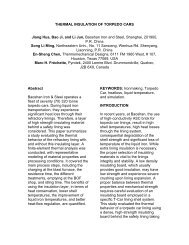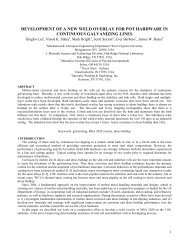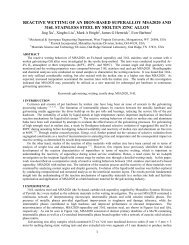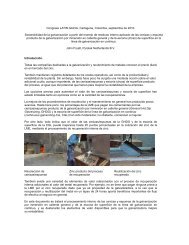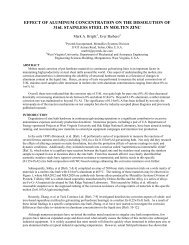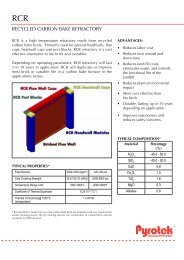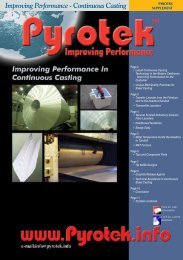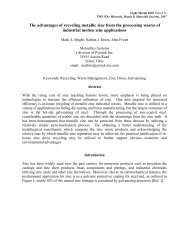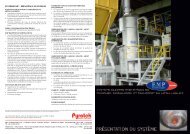Evaluating Molten Metal Cleanliness for Producing High ... - Pyrotek
Evaluating Molten Metal Cleanliness for Producing High ... - Pyrotek
Evaluating Molten Metal Cleanliness for Producing High ... - Pyrotek
Create successful ePaper yourself
Turn your PDF publications into a flip-book with our unique Google optimized e-Paper software.
<strong>Evaluating</strong> <strong>Molten</strong> <strong>Metal</strong> <strong>Cleanliness</strong><br />
<strong>for</strong> <strong>Producing</strong> <strong>High</strong> Integrity<br />
Aluminum Die Castings<br />
In the production of high integrity castings by a variety<br />
of processes — low pressure, high pressure, squeeze<br />
casting, precision sand — today’s marketplace demands<br />
a high quality standard. It is no longer possible to have<br />
the casting process by itself “rescue” the quality of the<br />
metal and produce a good casting from less-than-desirable<br />
molten metal quality. The pressure die casting<br />
process has advantages as well as disadvantages in its<br />
ability to produce a high integrity casting. However,<br />
molten metal quality is a key factor in the overall process.<br />
This means that an aluminum die cast alloy melt<br />
must be suffi ciently free of inclusions and hydrogen gas<br />
— which are the principal impurities — to produce the<br />
desired casting and quality required by the customer.<br />
Inclusions in the melt arise from oxidation and dross<br />
<strong>for</strong>mation, additives, fl uxes, returns, and refractory<br />
erosion. In addition, other inclusions can be created by<br />
metallurgical reaction within the melt. These include<br />
sludge <strong>for</strong>mation, heavy metal segregation, and any<br />
metallic contaminants whose concentration is in excess<br />
of solubility limits, which then <strong>for</strong>m intermetallic precipitates.<br />
Dirty furnace tools can be a source of inclusions,<br />
principally oxides, and hydrogen as well, through<br />
fl ux and dross residues and minor amounts of water<br />
of hydration or adsorbed moisture. The consequences<br />
of such inclusions, not removed, can be signifi cant<br />
— depending on their size, concentration, and most<br />
importantly, their location within the casting, and how<br />
they affect the functionality of the casting.<br />
Hydrogen is the only gaseous species that is soluble<br />
in aluminum. Hydrogen can be picked up from humidity<br />
in the air, from fossil fuel decomposition, returns<br />
bearing lubricant residues, and machined scrap castings.<br />
If not controlled suffi ciently, high amounts of hydrogen<br />
in the liquid state can be retained during solidifi cation,<br />
resulting in pore <strong>for</strong>mation. Historically, there was little<br />
concern <strong>for</strong> hydrogen in the melt <strong>for</strong> the production of<br />
pressure die castings. The rapid solidifi cation tended to<br />
“freeze-in” the hydrogen in a widely dispersed state and<br />
in the fi nal regions of the casting to solidify — often in<br />
the interior of “beefy” castings which were not subject<br />
to signifi cant engineering stress in that area. However,<br />
today’s more intricate cast structures, and greater<br />
demand on engineering properties has meant that<br />
hydrogen content can no longer be ignored. For many<br />
castings, especially those that must be pressure tight<br />
or are to be heat treated, hydrogen porosity cannot<br />
be tolerated. But it must be understood that porosity<br />
in high integrity pressure die castings can also result<br />
from inadequate venting of entrapped air as the metal<br />
solidifi cation front displaces the air ahead of it in the<br />
David V. Neff, Manager, <strong>Molten</strong> <strong>Metal</strong> Treatment<br />
Metaullics Systems<br />
Solon, Ohio<br />
die cavity. Additionally, lubricant decomposition can<br />
also generate porosity <strong>for</strong>mation.<br />
To control impurities — inclusions and hydrogen<br />
— a variety of melt treatment techniques are commonly<br />
employed. These include fl uxing in the melter or re-melt<br />
furnace, degassing and fl ux injection in the furnace or in<br />
transfer ladles, and fi ltration in melters and in holding/<br />
casting furnaces. Process development studies generally<br />
will defi ne the parameters necessary in the application<br />
of these technologies to meet internal standards and/or<br />
specifi c customer quality requirements.<br />
But how is melt quality evaluated, other than being<br />
“on composition” — and how is the melt suitable <strong>for</strong><br />
production of a given casting? Correspondingly, how is<br />
it known what “buttons to push” — determining which<br />
melt treatment(s) to use and to what extent? Fortunately,<br />
there are several readily available melt quality<br />
determination technologies, including new ones, which<br />
the die caster can employ. Fundamentally, the function<br />
of these evaluation techniques is to (1) assess quality of<br />
the melt and suitability <strong>for</strong> casting; (2) determine, monitor,<br />
confi rm, and verify the capabilities and continuing<br />
per<strong>for</strong>mance of various melt treatment processes which<br />
the die caster or foundry may wish to employ.<br />
However, many of these techniques which are currently<br />
available to the die caster at reasonable cost provide<br />
evaluation of only a small quantity of metal, and<br />
not all will provide real-time results. The true measure<br />
of consistent melt quality and successful melt treatment<br />
process lies in the consistency of producing acceptable<br />
quality castings. Nevertheless, these evaluation techniques<br />
still provide a good means of evaluation and<br />
control of molten metal quality.<br />
The fundamental features and a sampling of results<br />
are now herein described <strong>for</strong> many of the most popular<br />
technologies currently available.<br />
Reduced Pressure Test<br />
Arguably one of the most common, quick, simple, and<br />
low cost techniques, the reduced pressure test, is a realtime<br />
shop fl oor test method commonly used in virtually<br />
all low pressure, permanent mold, and green sand<br />
foundries. This test is becoming more commonly used<br />
as a quality tool in die casting foundries today. Shown<br />
in fi gure 1, the test consists of a small sample of aluminum<br />
which is harvested from the melt and allowed to<br />
solidify under controlled reduced pressure conditions,<br />
reaching a specifi ed reduced pressure in a given short<br />
time. The resultant determination is usually a calculation<br />
of specifi c gravity or density utilizing Archimedes’<br />
2/DIE CASTING ENGINEER September 2004 www.diecasting.org/dce
Figure 1: The reduced pressure test apparatus.<br />
Figure 2: Relationship between reduced pressure test and<br />
hydrogen content. 1,2<br />
principle and comparing this value with the theoretical<br />
value <strong>for</strong> the alloy in question. Alternatively or additionally,<br />
the solidifi ed sample may be sectioned and viewed<br />
in comparison with a visual chart which shows different<br />
numerically-assigned values based on different amounts<br />
of hydrogen-induced porosity resulting from different<br />
melt quality levels. The reduced pressure test is quick<br />
and many casting customers specify its use as a quality<br />
determinant in their casting process purchase specifi cation.<br />
However, it must be realized that this is a semiquantitative<br />
test, it is not a true measure of hydrogen<br />
content. Inclusions will nucleate pore <strong>for</strong>mation during<br />
solidifi cation as hydrogen atoms nucleate as molecules<br />
on the internal surfaces represented by inclusions.<br />
Nevertheless, the test is very useful and still allows a<br />
correlation to be made between density as measured by<br />
reduced pressure test, and actual hydrogen as evaluated<br />
by the Alscan technique, whose discussion follows. As<br />
shown in fi gure 2 <strong>for</strong> unmodifi ed and un-grain refi ned<br />
356 alloy, a correlation can be determined. 1,2 Similar<br />
correlations can be established <strong>for</strong> other alloys as well.<br />
Alscan<br />
The Alscan (Alcan) and its predecessor, Telegas<br />
(Alcoa) are two instruments which measure true hydrogen<br />
content directly, by the principle of closed loop<br />
re-circulation. Using an immersion probe containing a<br />
small amount of carrier gas (argon or nitrogen), the gas<br />
is continuously circulated in a closed loop until equilibrium<br />
is reached with the hydrogen gas dissolved in the<br />
melt. The hydrogen concentration in the melt can then<br />
be determined as a function of the partial pressure of the<br />
hydrogen content in the carrier gas. The results are managed<br />
through the electronic circuitry associated with the<br />
unit, and a measurement can be made in 15 minutes.<br />
LiMCA<br />
The LiMCA, or Liquid <strong>Metal</strong> <strong>Cleanliness</strong> Analyzer,<br />
was originally developed (by Alcan) <strong>for</strong> wrought aluminum<br />
cleanliness analysis, but has subsequently been<br />
applied in several instances to foundry alloy casting.<br />
This is a truly on-line technology, though its cost has<br />
limited its usefulness in the foundry industry to mainly<br />
process evaluations by large casting concerns. The<br />
LiMCA is based on the principle of allowing liquid<br />
metal to pass through a small orifi ce in a tube which<br />
measures the voltage potential between two electrodes.<br />
When an inclusion enters the orifi ce, it displaces liquid<br />
and creates a rise in electrical resistance. The subsequent<br />
voltage change observed can be correlated<br />
with the actual inclusion size and concentration. This<br />
in<strong>for</strong>mation can be displayed on a computer screen.<br />
The continuous measurement of inclusion size distribution<br />
provides a monitoring technique most useful <strong>for</strong><br />
continuous fl ow processes. While this technology is<br />
predominantly employed in process studies by wrought<br />
producers, it is conceivable that greater adaptation will<br />
occur in foundry casting in the future.<br />
PodFA and LAIS<br />
Figure 3a: The LAIS sampling technique.<br />
These techniques are different<br />
in their sampling procedure,<br />
but both require similar laboratory<br />
analysis. Consequently,<br />
they are not suitable <strong>for</strong> online<br />
melt quality determinations, but<br />
are very useful in establishing<br />
process treatment and qualifi -<br />
cations. Figure 3a and Figure<br />
3b portray the two techniques,<br />
schematic of the LAIS and the<br />
apparatus <strong>for</strong> the PodFA. In<br />
the fi rst, the LAIS, or liquid<br />
aluminum inclusion sampler, the<br />
sampling device is placed directly<br />
into the molten metal, which<br />
Figure 3b: PodFA.<br />
www.diecasting.org/dce September 2004 DIE CASTING ENGINEER/3
is aspirated into a test canister by vacuum. The metal<br />
passes through a very fi ne test fi lter disc which concentrates<br />
inclusions on the surface. The PodFA, or Porous<br />
Disc Filtration Apparatus, is an external test which<br />
pressurizes liquid metal sampled from the melt through<br />
a similar fi ner fi lter disc. Both techniques then require<br />
metallographic preparation and examination of the<br />
inclusion content contained on the surface of the fi ne<br />
fi lter disc. Results are reported with the evaluation of an<br />
experienced technician in terms of areal fraction of the<br />
inclusions observed as a function of metal volume passing<br />
through the test fi lter. The standard unit of measure<br />
is mm2 (area)/kg (volume). Both sampling techniques,<br />
however, involve “grab” samples of small melt quantities<br />
(only about 1 kg) so care must be taken in proper<br />
sampling to be representative of the larger melt.<br />
An example of the usefulness of this technique is<br />
shown in fi gure 4. In fi gure 4(a), the LAIS method has<br />
been employed to evaluate elongation in 319 alloy as a<br />
function of several melt treatments. 2,3 In fi gure 4(b), a<br />
die cast alloy melt has been examined using the PodFA<br />
technique be<strong>for</strong>e and after fl ux injection in a transfer<br />
ladle, and also after subsequent fi ltration in a casting/<br />
holding furnace. 4 The validity of both melt processes<br />
in improving the melt quality is demonstrated.<br />
Figure 4a: <strong>Evaluating</strong> elongation vs. melt treatment<br />
condition by LAIS. 2,3<br />
Figure 4b: PodFA results on 380 alloy <strong>for</strong> fl ux injection<br />
and fi ltration.<br />
Prefil<br />
The Prefi l ® Footprinter<br />
(N-Tec), fi gure 5, is a device<br />
which provides a real-time<br />
indicator of melt quality by<br />
measuring the weight of<br />
molten aluminum fl owing<br />
by gravity through a fi ne test<br />
fi lter as a function of time.<br />
This shop fl oor test can be<br />
per<strong>for</strong>med in less than three<br />
minutes, and a load cell and<br />
electronics weighing the<br />
molten aluminum which<br />
fl ows into the collector pan<br />
allows online monitoring<br />
and quality control. A fl ow<br />
curve is generated which<br />
can be compared, i.e. “bench-marked”, against pre-programmed<br />
similar curves from a confi dential industrywide<br />
database <strong>for</strong> a given alloy and temperature. Some<br />
indication of inclusion types can be garnered from the<br />
shape of the curve, but as with the PodFA and LAIS<br />
techniques subsequent quantitative inclusion analysis<br />
must be determined through metallographic and image<br />
analysis techniques on the inclusions concentrated on<br />
the test fi lter disc. Figure 6 portrays a Prefi l fl ow curve<br />
with metal evaluated be<strong>for</strong>e and after a fi lter in a die<br />
cast holding furnace. 4 Filtered metal demonstrates a<br />
greater volume of metal per unit time fl owing through<br />
the test system then the unfi ltered metal on the inlet<br />
side of the fi lter.<br />
Figure 6: Production result using prefi l. 4<br />
Figure 5: Prefi l footprinter.<br />
K-Mold<br />
This is a simple shop fl oor, foundry-friendly test comprising<br />
a stepped chill mold with notches to permit<br />
easy fracture and examination of the fracture surface.<br />
Operators can gain suffi cient expertise in just a couple<br />
of days experience in looking at the fracture surfaces<br />
with the naked eye under good lighting, or with a low<br />
power (10X) portable microscope. Only macro inclusions<br />
or discontinuities — 60-80 microns or greater,<br />
can be discerned easily with this test. Discontinuities<br />
on the fracture surface are counted as a function of the<br />
4/DIE CASTING ENGINEER September 2004 www.diecasting.org/dce
total number of samples investigated — fi ve bars of four<br />
fracture surfaces each. An “index” can be determined as<br />
the total number of discontinuities (inclusions or pores)<br />
observed, or the number of discrepant samples divided<br />
by 20. The index number can then be compared to any<br />
standard, previously established, which governs the<br />
suitability of the metal <strong>for</strong> making a particular casting.<br />
As usual, the technique can be used to establish specifi c<br />
process parameters and any melt treatment necessary.<br />
Figure 7 displays several days average results <strong>for</strong> unfi ltered<br />
versus fi ltered metal as one example. 4<br />
Figure 7: K-Mold results production foundry.<br />
<strong>Metal</strong> Vision<br />
The <strong>Metal</strong> Vision system employs ultrasonic technology<br />
to detect and measure the size and quantity of inclusions<br />
within a melt. While ultrasonic evaluations are<br />
routinely employed as quality determinators on solid<br />
castings in many instances, this technology has only<br />
recently been applied to liquid metal. Based on adaptation<br />
of sonar technology which dates back more than<br />
50 years, this technique uses ultrasonic attenuation and<br />
refl ection of a signal which can be correlated with the<br />
particle size distribution and concentration of inclusions<br />
within the melt. The system consists of a set of<br />
special guide steel rods which introduce high frequency<br />
sound waves into the molten aluminum and receive<br />
the response signals. The electronic package creates a<br />
continuous read-out of the result, enabling the foundry<br />
to monitor inclusion level as a function of time, charging<br />
condition, or other circumstance. As with the other<br />
evaluation techniques, it is possible to assess and/or<br />
monitor the progress of a specifi c melt treatment, as<br />
illustrated in fi gure 8. This chart shows the substantial<br />
improvement in reduction of inclusion particles within<br />
the melt as rotary degassing is employed in a crucible<br />
furnace. 5 The degassing process though primarily<br />
intended <strong>for</strong> degassing, has also reduced the inclusion<br />
level as the gas bubbles evolved during the degas<br />
process also provide some degree of inclusion fl otation,<br />
thus improving the melt cleanliness. The <strong>Metal</strong> Vision<br />
System continues to undergo development and may<br />
offer the die casting foundry a very valuable tool.<br />
Figure 8: Utilization of metal vision ultrasonic testing to<br />
evaluate melt cleanliness.<br />
<strong>Metal</strong> Health System<br />
The <strong>Metal</strong> Health ®<br />
System (N-Tec)<br />
is comprised of a<br />
heated, portable<br />
trolley and a series<br />
of molds. The<br />
unit is depicted<br />
in fi gure 9a. The<br />
principal benefi t of<br />
this testing system,<br />
which encompasses<br />
several evaluation<br />
Figure 9a: <strong>Metal</strong> Health system.<br />
techniques in a<br />
modular package,<br />
is to evaluate initial<br />
melt quality and resultant melt treatment parameters<br />
in process development and readiness of the melt <strong>for</strong><br />
casting. Coupled with other technologies such as Prefi l<br />
or PodFA, the <strong>Metal</strong> Health System allows diagnosis,<br />
spot checking and verifi cation of melt and process <strong>for</strong><br />
casting suitability.<br />
The several molds, portrayed in fi gure 9b, include a<br />
fl uidity fi nger tree, a “dog-bone” hot tearing mold, a<br />
multi-cavity tensile bar mold, the Tatur shrinkage and<br />
porosity mold, and a coarse-inclusion mold (i.e. the<br />
“K-mold”). The sampling techniques to utilize each<br />
mold are fairly straight<strong>for</strong>ward and do not require great<br />
sophistication or time on the foundry fl oor. Evaluation<br />
of the results can be made in the die caster’s own<br />
Figure 9b: <strong>Metal</strong> Health System mold modules.<br />
www.diecasting.org/dce September 2004 DIE CASTING ENGINEER/5
laboratory. While all test mold modules have application<br />
to several casting processes, the fl uidity mold may be the<br />
most useful <strong>for</strong> die casters.<br />
<strong>Metal</strong> fl uidity is an important factor in die fi ll of thin<br />
sections, and fl uidity in this test is very dependent on<br />
melt cleanliness — inclusion as well as hydrogen content.<br />
In the fl uidity mold, a precise amount of metal is<br />
poured at a controlled temperature, into a heated mold.<br />
The liquid metal travels through fi ve channels of equal<br />
length but varying depth. The distance the melt travels<br />
is then measured versus the total length available<br />
through the fi ve channels, generating a “fl uidity index”<br />
numerical result. Because the liquid metal is maintained<br />
at a fi xed temperature in the heated mold, no solidifi cation<br />
is involved, and the only impediment to metal fl ow<br />
is inclusion content and the basic viscosity of the alloy<br />
composition being tested. This test thus provides good<br />
sensitivity of the melt to specifi c alloy composition, as<br />
well as to cleanliness variations. Figure 10 demonstrates<br />
the quantitative capability of this test, generating a<br />
fl uidity characteristic profi le, length of fi nger the liquid<br />
metal travels, <strong>for</strong> the melt condition under evaluation.<br />
Comparisons can be made, of course, with a foundry’s<br />
existing database <strong>for</strong> a given alloy, comparisons between<br />
several melt treatments, or with general industry benchmarking<br />
ranges available through a separate package.<br />
Figure 10: Schematic, melt fl uidity using MHS fl uidity mold.<br />
Qualiflash<br />
Another fl uidity test that has been used by some<br />
metalcasters is the Qualifl ash. In this technique, a<br />
standard volume of metal at a given temperature is<br />
permitted to pass through a relatively coarse cellular<br />
ceramic fi lter into a stepped pan below. The more fl uid<br />
the metal, the greater number of “steps”, 1 through 8,<br />
that the metal will occupy, hence generating a Qualifl<br />
ash fl uidity number. Again, distinctions can be made<br />
between “cleaner” metal versus “dirtier metal” and<br />
process treatment conditions and casting suitability can<br />
thus be established relative to specifi c quality requirement<br />
needs.<br />
Other Melt Evaluation Techniques<br />
For the sake of completeness, it should be noted that<br />
traditional pressure die castings generally have not<br />
required either silicon phase modifi cation or grain<br />
refi ning in the melt stage. The rapid solidifi cation<br />
occurring with pressure die casting provides a suffi<br />
ciently fi ne alloy microstructure otherwise, although<br />
modifi cation has been shown to enhance die casting<br />
nevertheless. However, low pressure, squeeze cast,<br />
permanent mold, and precision sand casting processes<br />
do require these technologies, especially when producing<br />
high integrity castings. Standard grain refi ning and<br />
thermal analysis tests are readily available on a real-time<br />
basis to provide predictability of the effectiveness of<br />
grain refi ner and modifying agent additions.<br />
Summary<br />
A high degree of molten metal cleanliness is paramount<br />
in order <strong>for</strong> the caster to produce high integrity<br />
die castings which must meet signifi cant engineering<br />
requirements. Not only automotive die castings, but<br />
computer and electronic, aerospace, and even today’s<br />
consumer castings have exacting quality standards<br />
which must be met. <strong>Evaluating</strong> molten metal cleanliness<br />
is a necessary prerequisite to be able to produce a<br />
high quality casting. Several existing analytical techniques<br />
are available — some real-time, others augmented<br />
by further laboratory analysis — which enable<br />
the die casting foundry to assess (1) the suitability of<br />
metal ready <strong>for</strong> casting in the instance of real-time<br />
tests; and (2) process monitoring and validation of one<br />
or more melt treatment processes with evaluation by<br />
real-time and/or off-line techniques.<br />
In the fi nal analysis, these measurement techniques<br />
must be coupled with actual sustained foundry results<br />
— production of acceptable castings with lower scrap<br />
rates — which provides the fi nal validation.<br />
Each die caster will have specifi c needs, resources,<br />
and capabilities, as well as economic circumstances,<br />
with which to employ these various technologies. However,<br />
market necessities and world-wide competition<br />
means that ever increasing utilization of several of these<br />
melt quality evaluation techniques will be needed by<br />
the successful producer of high integrity die castings.<br />
References:<br />
1. B. DasGupta, L. Parmenter and D. Apelian, “Relationship<br />
Between the Reduced Pressure Test and Hydrogen Content of the<br />
Melt”, Proceedings, 5th International Conference on <strong>Molten</strong> <strong>Metal</strong><br />
Processing, AFS, Orlando, 1998, p. 285.<br />
2. <strong>High</strong> Integrity Aluminum Diecastings, ed. Apelian and Makhlouf,<br />
NADCA, 2004.<br />
3. S. DasGupta, D. Apelian, “Interaction of Initial Melt <strong>Cleanliness</strong>,<br />
Casting Process, and Product Quality: <strong>Cleanliness</strong> Requirements<br />
<strong>for</strong> a Specifi c Use, Proceedings, 5th International Conference on<br />
<strong>Molten</strong> Aluminum Processing, AFS, Orlando, 1998, p.234.<br />
4. D. V. Neff, “Using Filters and <strong>Evaluating</strong> Their Effectiveness in <strong>High</strong><br />
Pressure Diecasting”, NADCA Congress, Chicago, September 2002.<br />
5. R. Gallo, H. Mount<strong>for</strong>d, I. Sommerville, “Ultrasound <strong>for</strong> On-Line<br />
Inclusion Detection in <strong>Molten</strong> Aluminum Alloys: Technology<br />
Assessment” Proceedings, International Conference on Structural<br />
Aluminum Casting, AFS, Orlando, November, 2003.<br />
<br />
For Further In<strong>for</strong>mation Contact:<br />
D. V. Neff<br />
Metaullics Systems<br />
31935 Aurora Road<br />
Solon, OH 44139<br />
phone 440-349-8864<br />
email dvneff@metaullics.com<br />
6/DIE CASTING ENGINEER September 2004 www.diecasting.org/dce





